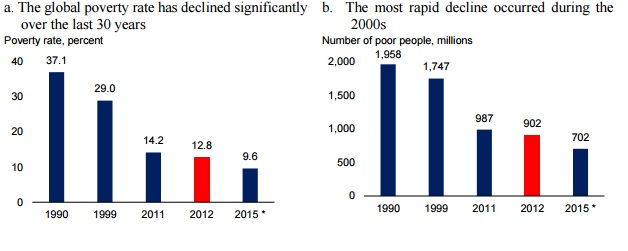India’s poverty rate falls from highest in 2012 to lowest among nations with poor population: World Bank
 WASHINGTON: India accounted for the largest number of poor people in any country in 2012, but its poverty rate was lowest among countries having large number of poor population, a latest World Bank report has said.
WASHINGTON: India accounted for the largest number of poor people in any country in 2012, but its poverty rate was lowest among countries having large number of poor population, a latest World Bank report has said.
According to the report, the number of people living in extreme poverty around the world is likely to fall to under 10% of the global population in 2015.
“India was home to the largest number of poor in 2012, but its poverty rate is one of the lowest among those countries with the largest number of poor,” the bank said.
Giving fresh evidence that a quarter century long sustained reduction in poverty is moving the world closer to the historic goal of ending poverty by 2030, it said a new methodology applied to household surveys in India suggests that its poverty rate could be even lower.
According to the report, the poverty rate in low income countries averages 43% in 2012, compared to 19% in lower-middle-income countries. Yet lower middle-income countries are home to about half of the global poor, compared to a third for low-income countries.

Part of the reason is that four nations with the largest populations were once classified as low-income but have moved into lower-middle-income category: China, India, Indonesia and Nigeria.
The report also notes that there’s a huge difference in the percentage of poor population among the countries that have the highest poverty.

Noting that connective infrastructure is a crucial means of linking the farms and firms where the poor live and work to markets, the bank said rural electrification in India has caused changes in consumption and earnings, with increase in the labour supply of both men and women, and promoted girls’ schooling by reallocating their time to tasks more conducive to school attendance.
Investment in integration and connectedness through railroads in India helped reduce the exposure of agricultural prices and real income to rainfall shocks, and helped diminish the famine and mortality risks associated with recurrent weather shocks, it said.
In its report, the bank uses an updated international poverty line of $1.9 a day, which incorporates new information on differences in the cost of living across countries.The new line preserves the real purchasing power of the previous line (of $1.25 a day in 2005 prices) in the world’s poorest countries.
Using this new line (as well as new country-level data on living standards), the bank projects that global poverty will fall from 902 million people or 12.8% of the global population in 2012 to 702 million people or 9.6% of the global population this year.
“This is the best story in the world today. These projections show us that we are the first generation in human history that can end extreme poverty,” World Bank Group President Jim Yong Kim said.

